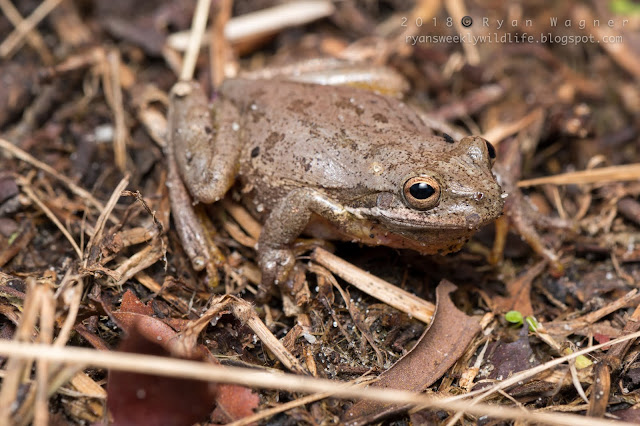Since the semester began, my ornithology class has been collectively anticipating our South Carolina trip with a mix of excitement and apprehension. Many of my classmates had never been camping before, and this was going to be the longest most of us had ever gone without running water. To further complicate things, the recent hurricanes posed a serious flood risk for many of the areas we hoped to visit. With our date of departure fast approaching, Dr. Miles was constantly checking the forecast and the state's water levels. We feared our primitive campground would be inaccessible, and the weather too harsh for birds or birders alike. If conditions didn't improve, the trip might not happen at all, but we remained optimistic. On the morning of October 4, we met at Irvine at 5 am, packed our gear Janga-style, and braced ourselves for the long ride to the Palmetto State.
 |
| Eastern Narrow-mouthed Toad |
Ten hours, two vans, seventeen birders, and too few bathroom breaks later, we arrived at our campsite. I rushed out of the van, eager to be on solid ground. We quickly erected a city of multicolored tents around our picnic table and portable camp stove (Dr. Miles is a damn good cook). That’s when we first noticed the mosquitoes. DEET chocked my lungs and throat as a dozen spray bottles appeared from pockets and bags. In the long run, these efforts would do little to ward off the incessant insects. By the end of the four days, I received more mosquito bites than I have ever had (my multitude of red bumps could have easily been mistaken for poison ivy).
As I scanned the darkening campground with my headlamp. Dozens of pinpricks of light winked back like stars hidden in the grass—eye-shine from countless prowling wolf spiders on the hunt for unsuspecting invertebrates. This particular discovery was met with horror from most of the group. The spiders were large, but clearly harmless—that is, until someone found a black widow near the base of a tree. We all grew much more cautious as we swept our way through the underbrush after that.
 |
| Eastern Spadefoot |
Now that we were in a new state, birds were not the only thing on my mind. South Carolina is home to a diverse array of herpetofauna vastly different from Ohio’s. Every divot in the substrate, every lump of sand, every shiny rock, slick with dew, held false promise of frogs. The day had been horribly hot, near 90 degrees, and muggy. As darkness set in, the night grew comfortably cool, but the humidity remained. It seemed like a good night for terrestrial amphibians.
 |
| Eastern Spadefoot |
Something small and reflective scuttled past my shoe. Frog or Spider? Bending down, I was delighted to find that the little creature was a narrow-mouthed toad (Gastrophryne carolinensis)—a species I had hoped we might find. Plucking the toad from the earth revealed one of the smallest adult frogs I had ever seen. It was scarcely bigger than a quarter with small, thin legs, a clay-colored back, and purplish sides and stomach. Small-mouth toads are a wide ranging species, found in moist habitats and under cover across much of the southeastern United States. As the group admired the little toad, another, larger frog was discovered—one I never imagined we would see.
My jaw dropped as someone brought over a medium-sized purplish-brown frog with enormous, luminous yellow eyes. In Ohio, eastern spadefoot toads (Scaphiopus holbrookii) are extremely endangered, found in only a few southern counties where they are active during heavy rainstorms a few nights each year. To see one here, in our campground, on a clear night, baffled me. Eastern spadefoots occur throughout the coastal planes, only reaching Ohio at the extreme northern tip of their range. In the south they can be downright common. We found ten easily as they grumpily hopped through camp.
 |
| Barking Treefrog |
The third and most beautiful frog species of the night was also discovered on a whim. I noticed the stunning green frog as we weaved between spiderwebs and branches. It was poised motionless at the end of a stick like a glittering green stone. I knew immediately it was a treefrog, but what species alluded me. I later learned that the specimen we found was a barking treefrog (Hyla gratiosa), identifiable by its large size and granular skin. The barking treefrog is another inhabitant of the coastal plains region where they can be quite common in wooded areas.
 |
| Green Treefrog |
By the end of the trip we would add the green treefrog (Hyla cinerea) and the pine woods treefrog (Hyla femoralis) to our list. I can only imagine the amount of amphibian diversity we could see if we had spent more time searching for them. Luck would have it that a former professor of Appalachian college was herping around our campsite. The final night of our trip he brought over several jars full of native salamanders and a few snake species he had caught the night before. I couldn't believe our luck. I will definitely need to return to South Carolina in the future to seek out its more obscure herpetofauna.
 |
| Pine Woods Treefrog |
The following day, we woke early and packed ourselves back into the vans (thankfully we had only a short distance to drive). We were in search of a rare and endangered species of woodpecker. Dr. Miles pointed out a longleaf pine with two freshly painted white rings around its base. The forest service had marked one of the bird’s nesting trees. Now all we had to do was wait and listen. . .
Keep Living the Field Life.













No comments:
Post a Comment